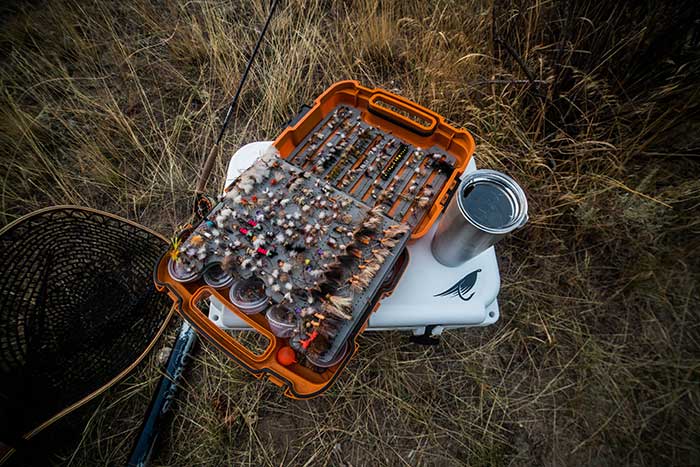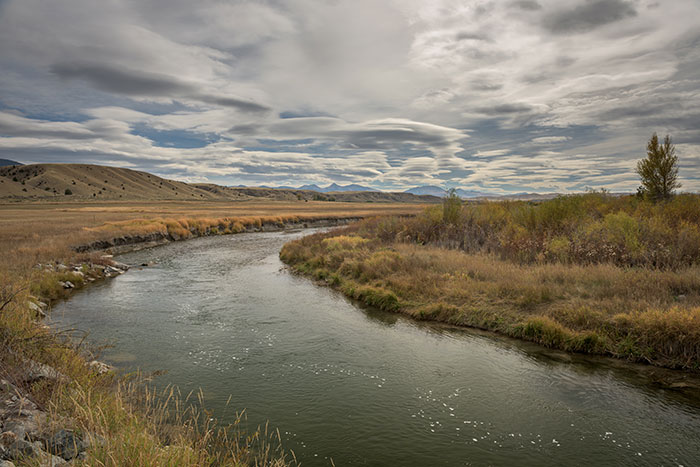
If you missed Part One of Wade’s interview, read it here; learn more about the Upper Missouri Waterkeeper here.
What’s been your most interesting experience as an angler?
The beauty of this sport is the opportunity to connect with nature on a deep level and in a unique way every time you string up a rod. I’ve celebrated the catch and release of a trophy trout with an entire community, seen countless spectacular sunrises and sunsets, encountered bears, been chased by moose, and nearly drowned. But what is most interesting to me is how many people take these instances for granted and plan to go experience them later, after they’re able to retire and when they have time. Go experience them now, while they’re still here, and spend the rest of your time working to preserve these places so your children have the opportunity to run like hell through the woods from wild animals!
What’s the one fly you always make sure is in your box?
My uncle and I used to play hop-scotch every August, fishing pocket to pocket in the mountain streams of SW Montana. We’d see who could catch the most fish on a classic size #14 stimulator before it fell apart. Stimulators dry quickly, land lightly, and look buggy enough to imitate a number of mountain insects throughout the season. One year he came limping back to the fly shop with a broken toe, a big grin, holding an unraveled fly and gloating about the fifty fish he’d landed!
Favorite species to pursue on the fly, and why?
Brown trout are the most fun to fish for because of their cunning. The rainbows are the most fun to catch because of their acrobatics. Whitefish have worked wonders for getting new anglers hooked on the “tug” and saved many a day in the dog days of summer. The grayling are unique to the Big Hole, they’re a disappearing arctic fish, and they’re extremely elegant. But my favorite is the west slope cutthroat. They’re native, feisty, love to eat on top, fight like hell, and they’re the species that we’ll be in danger of losing next if we don’t shift our land-use paradigm.
You can only bring five items on a trip / guide day. What makes the cut?
(1.) High quality polarized glass lenses are worth every penny. It’s a beautiful world and you should see it in deep color and without glare.
Fly rods are a lot like skis, find (2.) one you love and get good with it. Buying a new top sheet every year isn’t good for your pockets or your technique.
I’ve ditched vests and gone to a (3.) lightweight waterproof backpack. Orvis makes a great one with plenty of room for (4.) a good raincoat. Lastly, there’s a leather craftsman named Goertzen out of Missoula who makes the handiest and most (5.) durable fishing lanyard i’ve come across. It neatly holds all your tools, tippets, and flies and I’d be lost without it these days.

So what’s next—what’s on the docket for 2016?
Three big-ticket items folks should keep on their radar.
First, the foreign mining company – Tintina Resources – has officially applied for a copper mining license, located in the headwaters of Montana’s famed Smith River. This proposal is a classic example of the wrong project in the wrong place, unnecessarily risking a key headwater of the Missouri, not to mention the important values, local economy, and recreational opportunities the Smith currently supports.
Second, the Federal Energy Regulatory Commission (FERC) provided notice to the public last week that is ready to perform environmental reviews of the proposed Clark Canyon Dam Hydroelectric Project, sited at the Beaverhead River’s headwaters outside Dillon, MT. Everyone who cares about the Beaverhead has the right to submit comments to FERC urging them to carefully consider the hydro proposal and its potential to cause, contribute to, or exacerbate environmental issues. Your comments to FERC are critical to ensuring any final hydropower license contains science-based conditions that protect the river, fisheries, and important local economies! It is very important that the public make their voice heard now. FERC agreed to waive normal environmental review procedures or requests for additional, necessary scientific studies because it believes all relevant environmental issues are known and have been adequately studied. However, all relevant science isn’t being considered! Neither FERC nor the applicant are looking at emerging science detailing recent, harmful algal blooms and clarity problems on the Upper Beaverhead during 2014 and 2015, or examining the potential of a new hydropower facility to contribute to or worsen those water quality problems. This means the current public comment period is the only near-term opportunity citizens have to weigh-in on FERC’s review of the proposed Clark Canyon Hydroelectric Facility. We have provided two easy opportunities to get involved on our website.
Last, we’re hoping to publish – by the end of the year – the first in a series of “River Report Cards.” The concept is that the Upper Missouri River Basin contains some of our nation’s last, best rivers supporting fabulous fisheries, thousands of families’ drinking water, not to mention untold numbers of local business. It is critical that we understand long-term trends in water quality, fisheries viability, and local land use patterns so that we can effectively target areas affected by pollution or hot-spot issues, as well as protect critical headwater regions and their cool, clean flows. We’ll be holding a series of “Meet Your Waterkeeper” events in cities across the basin to discuss all of these issues further. These events are opportunities to meet our staff, learn more about your local rivers, as well as chime-in and tell your local water advocates about any water issues on your mind! We’re a grassroots-based organization covering a huge, 25,000 sq. miles area – we want to meet local folks who care about clean water and happy fish!
Ed.-Thanks to Wade and the team UMWK for taking the time to answer questions and chat about critical issues in the expanse of the upper Missouri watershed.
Image Credits: Top – Becca Skinner, Middle, The Ruby – Hank Wells, Bottom, Beaverhead Dam – UMWK


